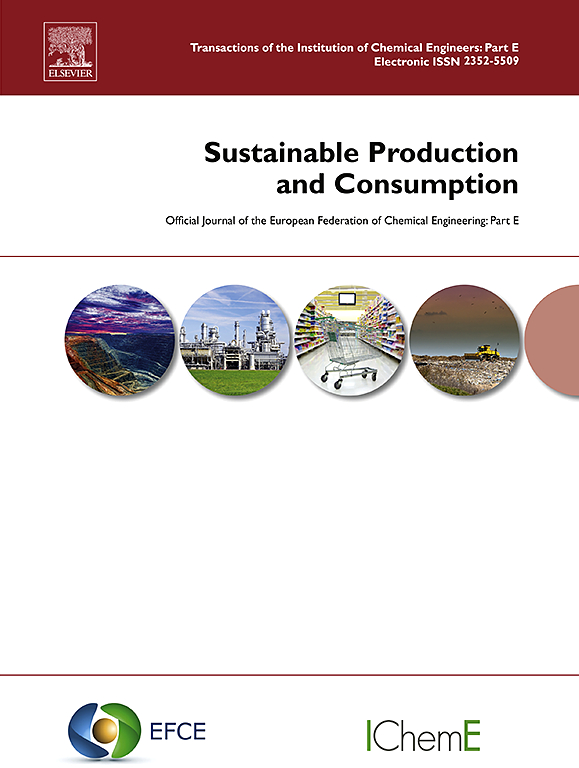药品对环境的影响:供应链中生产地点选择的影响
IF 10.9
1区 环境科学与生态学
Q1 ENVIRONMENTAL STUDIES
引用次数: 0
摘要
药物产品对环境的影响在很大程度上是由制药公司无法直接控制的活动决定的,例如制药构件的外包生产。因此,本研究评估了以一个泡罩(申报单位)包装的前列腺癌药物对环境的影响,从而分析了整个价值链,以深入了解:1)药物产品生产影响的主要因素;2)溶剂和药品生产的地理位置的影响。分别使用 IPCC 全球升温潜能值 100 和从自然环境中提取的累积能耗方法,确定了药物产品整个生命周期的碳足迹和资源足迹。与许多其他研究不同的是,该研究根据原始数据、文献和类似流程,对称为中间药物成分(IPIs)的构件的影响进行建模。每个申报单位的碳足迹相当于 34 千克二氧化碳当量,其中 IPIs 和活性药物成分 (API) 生产占 96%。资源足迹为 647 兆焦耳/申报单位,其中 IPI 和原料药生产占 93%。这些工艺的主要影响因素是溶剂和电力消耗。我们为 IPI 和原料药生产制定了四种备选方案,以评估欧洲和中国之间不同溶剂和药品生产地点的地理影响。欧洲的溶剂和药品生产似乎具有最低的碳足迹和资源足迹。相比之下,中国溶剂和药品生产的碳足迹增加了 49%,而资源足迹仅增加了 4%,尽管自然资源消耗从非生物可再生资源和核能转向了化石燃料。IPI 生产的高贡献率和供应链地理位置的影响突出表明,需要外部供应商提供准确的数据,以公平地估算药物产品的环境足迹。本文章由计算机程序翻译,如有差异,请以英文原文为准。
Environmental impacts of drug products: The effect of the selection of production sites in the supply chain
The environmental impact of drug products is largely determined by activities beyond the direct control of pharmaceutical companies, such as outsourced production of pharmaceutical building blocks. Therefore, this study evaluates the environmental impacts of a prostate cancer drug packaged in one blister (declared unit), thereby analysing the whole value chain to gain insight into 1) the main contributors to the impact of drug product production and 2) the effect of the geographical location of production of solvents and pharmaceuticals. The carbon and resource footprints of the entire life cycle of the drug product are determined, using the IPCC GWP 100 and the Cumulative Exergy Extraction from the Natural Environment methods, respectively. Unlike many other studies, the impacts of building blocks, called intermediate pharmaceutical ingredients (IPIs), are modelled based on primary data, literature and similar processes. The carbon footprint per declared unit equals 34 kg CO2-eq, of which IPIs and active pharmaceutical ingredient (API) production account for 96 %. The resource footprint is 647 MJex/declared unit, with IPI and API production accounting for 93 %. The main impact contributors of these processes are solvents and electricity consumption. Four alternative scenarios for IPI and API production are developed to evaluate the geographical influence of different production locations of solvents and pharmaceuticals between Europe and China. European production of solvents and pharmaceuticals appears to have the lowest carbon and resource footprint. In contrast, Chinese production of solvents and pharmaceuticals increases the carbon footprint by 49 %, while the resource footprint increases by only 4 %, although the natural resource consumption shifts from abiotic renewable resources and nuclear energy to fossil fuels. The high contribution of IPI production and the influence of geography of the supply chain highlight the need for accurate data from external suppliers to fairly estimate the environmental footprint of drug products.
求助全文
通过发布文献求助,成功后即可免费获取论文全文。
去求助
来源期刊

Sustainable Production and Consumption
Environmental Science-Environmental Engineering
CiteScore
17.40
自引率
7.40%
发文量
389
审稿时长
13 days
期刊介绍:
Sustainable production and consumption refers to the production and utilization of goods and services in a way that benefits society, is economically viable, and has minimal environmental impact throughout its entire lifespan. Our journal is dedicated to publishing top-notch interdisciplinary research and practical studies in this emerging field. We take a distinctive approach by examining the interplay between technology, consumption patterns, and policy to identify sustainable solutions for both production and consumption systems.
 求助内容:
求助内容: 应助结果提醒方式:
应助结果提醒方式:


